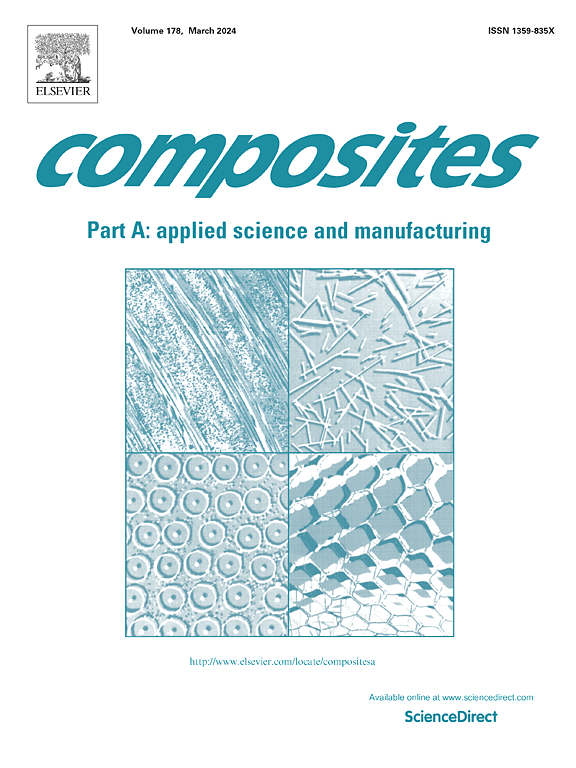A model to describe transient transverse deformation during prepreg consolidation
IF 8.1
2区 材料科学
Q1 ENGINEERING, MANUFACTURING
Composites Part A: Applied Science and Manufacturing
Pub Date : 2025-05-10
DOI:10.1016/j.compositesa.2025.109021
引用次数: 0
Abstract
In automated tape placement or other prepreg layup methods, one of the manufacturing flaws manifests when the gap between adjacent tapes or prepreg sheets cause concave deformation on top of the gap during the consolidation step. Our previous model addressed the development of the gap as applied to tape placement process and predicted final deformation state was compared with experimental measurements after tape consolidation was complete. The transient deformation behavior could not be verified as it was not possible to measure at that time. Since then, a unique fiber optic shape sensor was developed that measures the in-situ deformation of a cross-ply thermosetting composite laminate containing gaps of various widths in the middle layer during the entire consolidation process. The related experimental work showed that our previous model assumption of elastic behavior of prepreg plies bridging the gap are invalid. To address this shortcoming, elastic stress relaxation was introduced into the model. To address wider gaps, it also proved necessary to add the contact between the bridging layers and substrate under the gap. In addition, transient viscosity model was also implemented as the necessary data for its characterization was also available.
The extended model parameters were found by successfully fitting the transient deformation to one experimental result. The transient results were then compared to the fiber optic in-situ sensor data obtained in additional cases. The comparison of model predictions with experimental data proved favorable.
描述预浸料固结过程中瞬态横向变形的模型
在自动化胶带放置或其他预浸料铺设方法中,当相邻胶带或预浸料片之间的间隙在固结步骤中导致间隙顶部凹变形时,制造缺陷之一就会表现出来。我们之前的模型解决了应用于胶带放置过程的间隙的发展,并将胶带固化完成后预测的最终变形状态与实验测量结果进行了比较。由于当时无法测量,因此无法验证其瞬态变形行为。从那时起,一种独特的光纤形状传感器被开发出来,用于测量在整个固结过程中含有不同宽度的中间层间隙的交叉层热固性复合材料层板的原位变形。相关的实验工作表明,我们之前关于预浸料桥接间隙弹性行为的模型假设是不成立的。为了解决这一缺陷,在模型中引入了弹性应力松弛。为了解决更大的间隙,还需要在间隙下增加桥接层和基板之间的接触。此外,还建立了瞬态粘度模型,为其表征提供了必要的数据。通过将瞬态变形与一个实验结果成功拟合,得到了扩展模型参数。然后将瞬态结果与光纤原位传感器在其他情况下获得的数据进行比较。模型预测与实验数据的比较证明是有利的。
本文章由计算机程序翻译,如有差异,请以英文原文为准。
求助全文
约1分钟内获得全文
求助全文
来源期刊

Composites Part A: Applied Science and Manufacturing
工程技术-材料科学:复合
CiteScore
15.20
自引率
5.70%
发文量
492
审稿时长
30 days
期刊介绍:
Composites Part A: Applied Science and Manufacturing is a comprehensive journal that publishes original research papers, review articles, case studies, short communications, and letters covering various aspects of composite materials science and technology. This includes fibrous and particulate reinforcements in polymeric, metallic, and ceramic matrices, as well as 'natural' composites like wood and biological materials. The journal addresses topics such as properties, design, and manufacture of reinforcing fibers and particles, novel architectures and concepts, multifunctional composites, advancements in fabrication and processing, manufacturing science, process modeling, experimental mechanics, microstructural characterization, interfaces, prediction and measurement of mechanical, physical, and chemical behavior, and performance in service. Additionally, articles on economic and commercial aspects, design, and case studies are welcomed. All submissions undergo rigorous peer review to ensure they contribute significantly and innovatively, maintaining high standards for content and presentation. The editorial team aims to expedite the review process for prompt publication.
 求助内容:
求助内容: 应助结果提醒方式:
应助结果提醒方式:


